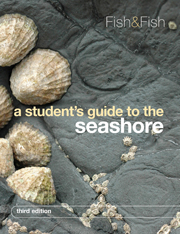Book contents
- Frontmatter
- Contents
- Preface
- Acknowledgements for illustrations
- Introduction
- Design and layout of the book
- Illustrated guide to the plants and animals of the shore
- Seaweeds
- Lichens
- Anthophyta
- Porifera
- Cnidaria
- Ctenophora
- Platyhelminthes
- Nemertea
- Priapula
- Annelida
- Mollusca
- Arthropoda
- Sipuncula
- Echiura
- Bryozoa
- Phoronida
- Echinodermata
- Hemichordata
- Chordata
- Bibliography
- Glossary
- Index
- Plate section
- References
Arthropoda
Published online by Cambridge University Press: 05 June 2012
- Frontmatter
- Contents
- Preface
- Acknowledgements for illustrations
- Introduction
- Design and layout of the book
- Illustrated guide to the plants and animals of the shore
- Seaweeds
- Lichens
- Anthophyta
- Porifera
- Cnidaria
- Ctenophora
- Platyhelminthes
- Nemertea
- Priapula
- Annelida
- Mollusca
- Arthropoda
- Sipuncula
- Echiura
- Bryozoa
- Phoronida
- Echinodermata
- Hemichordata
- Chordata
- Bibliography
- Glossary
- Index
- Plate section
- References
Summary
The arthropods include such well-known representatives as the insects, spiders, shrimps and crabs; they are a large grouping of invertebrate animals which have bilateral symmetry and show metameric segmentation, although the latter is not always clear. They are characterized by paired, jointed appendages and it is from this character that the group gets its name, arthropoda, meaning jointed feet. The appendages show great variation and serve a wide range of functions, including sensory perception, feeding and locomotion. The body is further characterized by the possession of a semi-rigid exoskeleton which in places is thin enough to allow movement. Periodically, the exoskeleton is shed by a process of ecdysis or moulting. A new skeleton develops under the existing one and during moulting the animal frees itself from the old skin which splits along lines of weakness. The new skin is soft and expands rapidly before hardening. Growth increments at moulting can be substantial: for example, the common shore crab increases in carapace breadth by an average of about 30%. The arthropods form the largest group in the animal kingdom and the possession of a hard exoskeleton is a major factor in their colonization of land, sea and air.
The arthropods are a large and diverse group and it is not surprising that the classification has been the subject of much debate. Although some authors consider different groups of arthropods to have different lines of ancestry (polyphyletic) and assign phylum status to these, it is now widely accepted that the arthropods have a single line of ancestry and are monophyletic, the position adopted here.
- Type
- Chapter
- Information
- A Student's Guide to the Seashore , pp. 298 - 376Publisher: Cambridge University PressPrint publication year: 2011



